Fine Art Studios
Bachelor of Arts (Fine Art) requires a two-stage enrolment process in 2019. In stage one, you will have enrolled online in courses for semesters 1 and 2 2019. Please ensure this stage one is complete before proceeding. In stage two, you will select semester two classes for your Fine Art Studio, Workshop and ART: History+Theory+Cultures 2019.
This page will assist you with stage two of the enrolment process. Here you will find a list of potential semester 2 Fine Art Studio classes.
(Note: There is a separate page for Workshop classes and a separate page for ART: History+Theory+Cultures classes).
You will only take one Fine Art Studio class in semester 2, but you need to list two (2) preferences. These Fine Art Studios will be for both first and second year students and will be offered under the following course codes:
Fine Art Studio 2 VART 3645 (1st year)
Fine Art Studio 4 VART 3647 (2nd year)
Read the list below carefully and select two Fine Art Studio classes you would be happy to enrol in for semester two. Remember, these Fine Art Studio classes are 24 credit point courses and will require 6 contact hours per week.
For more information about a course, please contact the Studio Lead of the offering studio. The 2019 preferencing process will be communicated to you by email at a later date.
IMPORTANT – You must not repeat any class in your preference lists. Every effort will be made to place you in your first preference classes.
Please note: although we would like to offer all of the options below, classes are subject to viability and may not run if numbers are too low.
Course Information
Offering Studio & Studio Lead
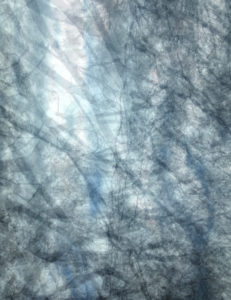
ANDREW GUNNELL, Untitled 2018 Digital Inkjet
Alchemy: Technique, Mediation and the Artist's Response
Through practical workshops this course introduces and explores a range of processes and techniques of lithography and etching as a medium that extends and compliments drawing. Using reproductive techniques with their inherent alchemy, history and transformative principles students will explore and develop strategies to respond to unintended results and the mediation of the medium with consideration of their idea. Students will be encouraged to find an alternative directions in order to produce new artworks while developing a generative art practice.

Olafur Elliasson, Ice watch, 2015,place du pantheon, Paris
ART / NATURE / CULTURE
This practical class will introduce you to contemporary art practices that engage with landscape, natural history and ecology. You will explore how painting and drawing has engaged historically with the natural world, reflecting cultural attitudes to nature and how multiple forms of contemporary art making have evolved in response to changing understandings of ecology and our place within it.
Areas of investigation may include:
- Historical and critical readings of landscape and natural history painting.
- Nature and Technology - How technological platforms alter both vision and conception of the planet, locally and globally.
- Contemporary modes of art making in the ecological space including: the relationship between art and science – the aesthetic means of interpreting and conveying discoveries through art.
- Nature and the gallery: how ecological issues, site specific, ephemeral and interactive projects reframe human engagement and our relationship to nature.
In this class you will develop art works that respond to the way the natural world is both experienced and conceived of in the contemporary context of the Age of Anthropocene.
You will participate in an Exhibition Project where you will curate, exhibit, critique and document your work in a collaborative group exhibition. This class is supported by group and individual tutorials and student presentations.

Photograph of Rachel Whiteread's studio by Nigel Shafran 2010
Drawing Atelier
In this course you will develop Drawing projects through their relations to your Studio practice. You will enrich and deepen your skill base and explore how to use and transform traditions of drawing and its development into other mediums within the atelier space of the studio.
The idea of atelier includes both the individual working space as well as the shared experience of studio as a community. You will explore graphic, pictorial and narrative themes, perception and translation of object, figure and image, and cycles & series of image making leading to the development of your self-directed and resolved projects. To gain experience, skills and knowledge in developing a career as a professional artist you may participate in a collaborative Exhibition Project.
Students in this course will share tutorials with the Drawing Identities & Transformation course. Additional lectures, life room experiences and museum excursions will investigate ways artists employ drawing concepts and methods that underpin and extend their studio–based drawing projects.

Copyright Arelene Texta Queen, Speak no, Year, 2017 felt tip pen on paper
Drawing Identities & Transformation
In this course you will further develop your Drawing practice as a broad-based contemporary art form. You will strengthen your skill base and test how drawing practices extend beyond the studio to both employ and transform identity. You will explore identity and transformative practices in relation to new ways of making and installing a range of works. A selection of initial themed projects will lead to you developing a self-directed and resolved body of work.
To gain experience, skills and knowledge in developing a career as a professional artist you may participate in a collaborative Exhibition Project. Students in this course will share tutorials and resources with the Drawing Atelier course. Additional lectures, skills demonstrations and gallery visits will demonstrate how contemporary artists employ drawing concepts and methods that directly extend their studio practice.
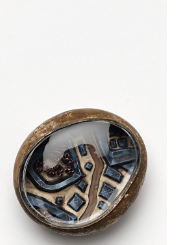
Stephen Robb
Cell series (object), 2012
Acrylic, copper, shibuichi, acrylic, paint
Gold & Silversmithing Narratives
In this course, you will undertake a series of creative projects where you will explore how the narrative can be used as a starting point in creating Jewellery and Objects. One by one you will explore the malleability of materials and create alloys of copper and silver. Through the use of metal punches and hammers you will stretch and transform the surface qualities of the metals you use. The projects are playful and the processes will complement your narrative and conceptual intentions by enabling you to create new and original forms and surfaces. At the completion of the semester you will have produced a body of jewellery and object works that tell a story.
This studio is for students with experience in jewellery and silversmithing.
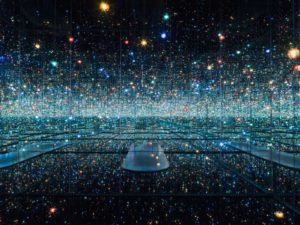
Yayoi Kusama "Infinity Room" 2015
Helsinki Art Museum (CC)
Installation Art
In this course you will explore installation as spatial practice. You will examine installation as a hybrid form that negotiates boundaries of traditional art practices such as painting, sculpture, live art, video, film and theatre. This course focuses on the history and critical reception of installation as a practice. You will investigate how conceptual, spatial and material needs define the language and application of installation art. Installation art has been a dominant mode since the 1960’s and over that time has evolved to continually reflect contemporary culture. This course will investigate the role of the artist as viewer in determining the presentation mode and how this has changed. The artist, through the process of installing their work in a gallery or museum, places the studio in the museum. We will be exploring how this process activates the viewer as a performer within the artists’ work. The artist by working in the museum context is locked into engaging in many of its conventions as described in Inside the White Cube by Brian O’Doherty. How architectural space functions in the presence of the artwork will be an important consideration of this course.
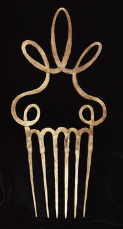
Alexander Calder,
HAIR COMB, C. 1940
Brass wire
10 3/8"" x 4 5/8""
Calder Foundation, New York
Jewellery for Artists
In this course students will be introduced to jewellery practices. The studio will focus on the engagement of the art jewellery object and how it is a portable canvas or sign. Possibilities are expanded by conceptualising an idea in order to create a jewellery object that is worn on the body. Students will use playful ideation processes and metal techniques to create wearable and unwearable jewellery objects.
This course is for students without jewellery skills and basic tools will be provided.
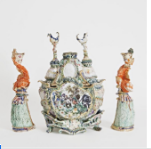
David Ray,Wild Thing,
2017, Earthenware, 66 x 66cm, Photographer: Artist
Making Ceramic History Present
Using the esteemed ceramic collection of the National Gallery of Victoria as a starting point, students source an object that peaks their imagination, passion or curiosity. This ‘historic’ and/or ‘significant’ object is the conduit for a conceptual and technical research. Students will be encouraged to develop an individual approach and interpretation to develop new work, utilising a range of ceramic techniques.
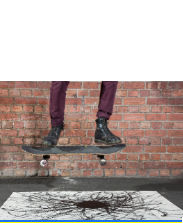
Performprint 2016, Out of the Matrix Exhibition, Image courtesy of Tobias Titz
Out of the Matrix
In this course you will explore the unique possibilities offered by the Matrix for duplication, multiplication and the unique through experimenting with reproductive technologies. You will utilise a range of technologies and materials, including digital, intaglio, photographic and/or serigraphic processes to diversify your options for print production. You will deepen your analytical thinking and making skills through the combination of conceptual and technical development. In consultation with your lecturer, you will take responsibility for the determination of your study program through set assignments with a major self directed studio project.

Louise Weaver, Blue Bell (Flower) 2015, Synthetic polymer emulsion on panel
Painting Diversification
In this course you will develop your own unique studio practice in relationship to the expanded field of painting that may include painting, collage, works on paper, the object and installation. You will experience new strategies for generating ideas and stimulating your imagination, that lead to the development of a flexible studio work proposal that is sustainable and research focused to your own individual ideas. Themes in contemporary art will be investigated to demonstrate how artists initiate, expand and maximise outputs through experimentation and research. Ideas may include: the body, nature, abstraction, materiality, colour, chance, series, memory, the known and the unknown. You will identify your field of practice and participate in an Exhibition Project where you will curate, exhibit, critique and document your work in a collaborative group exhibition. This will provide valuable information and experience in exhibition practice, gallery installation strategies and professional practice that will prepare you for a career in the arts industry.
You will experience individual tutorials, peer-to-peer discussion and group feedback sessions, field trips to NGV, demonstrations and health and safety; experiences that will enrich and sustain your continued development as artists in a supportive and stimulating environment.
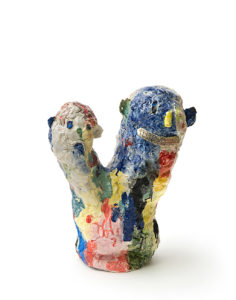
Samantha O'Farrell, 2018 Porcelain 45cm x 40cm Diam. Photographer: Andrew Barcham
The Ceramic Vessel as Political or Social Commentary
This course explores the contemporary ceramic vessel and how the vessel responds to socioeconomic, political and environmental conditions. Students will explore and experiment with different ceramic forming techniques and surface finishes in relationship to concept.

Phylidda Barlow, untitled: "upturnedhouse", 2012. Collection Tate / National Galleries of Scotland
Thinking through Making
This course aims to further develop your Sculptural practice by focusing on an individual and hands-on approach to making. You will begin the course by creating and documenting a series of works without predetermined outcomes. This will allow you to be productive in an intuitive and creative way and build a deeper understanding of your own interests. In response to this work, you will research and document a series of artists, works and themes or ideas and begin to build an archive of research material to draw on in the future. In the second half of the course you will use these early works, research materials and ideas to develop and present a major work or series of works.
This course aims to provide you with the tools to consolidate your work to date and to assist you in developing directions that you can potentially expand on as a professional artist or in further study.

Heather Phillipson, True to Size (2016)
Video Space and Surface
Time Space and Surface explores the combined practice of moving image and installation focusing on how the moving image may be experienced spatially and materially. Drawing on a variety of moving image devices such as projection, TV monitors, portable handheld devices and distributable media, we look at the moving image as both surface, and object, and how it may be considered and integrated materially into an expanded environment.
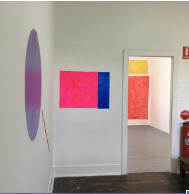
Robin Kingston.SNO untitled. 2017,Graphite and Acrylic on the wall. Sydney Non Objective. Dimensions relational to the site.
Wall and Space
In this studio-based class you will explore the historical and contemporary conceptions of wall and space as a site for art making, with particular reference to painting.
You will experience the design and production of your own wall painting within existing and virtual locations. Both expansive and small projects are encouraged. The history of fresco, stucco lucido and sgraffito as means of decorating the interior and exterior of buildings will be discussed and experienced.You will investigate the wall as site charged with political meaning, its material presence including immersive use of colour, pattern, repetition and decoration, personal symbolism and expression. You may experiment with the use of light and projection as it has been used by artists as an ephemeral way of visually altering and occupying the built environment. You may explore the potential for ceiling, walls and floor to create immersive experiences for the viewer, with particular reference to painting within the broader field of installation practice.
Through student projects and presentations, you will explore contemporary deconstructions of the painting as object and re/integration of art elements into architecture and the fabric of the built environment, in a range of locations. Second Year students will gain experience, skills and knowledge in developing a career as a professional artist through an Exhibition Project, where you will curate, and document your work in the form of a virtual exhibition.
The course will be delivered through flexible means - set project, lectures, student presentations, field trips and individual studio and group tutorials.